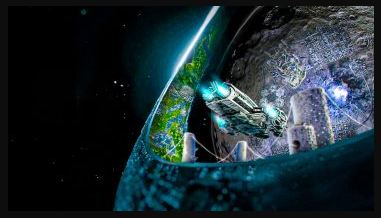Deciding on the Moon or Mars can be all of the buzzes. however how approximately all of us move to an icy dwarf planet within the middle of the solar machine? To Ceres. What could make this an amazing candidate for a space settlement? What type of orbiting habitat ought to we construct there? And what wouldn't it be like to decide the floor of this icy world?
Welcome to Ceres, the most effective dwarf planet inside the inner solar gadget. With a radius of 476 km (296 mi), Ceres is thirteen instances smaller than Earth. however it’s the largest object positioned within the asteroid belt among Mars and Jupiter. And it appears just like our very own Moon.
here on Ceres, an afternoon is simplest 9 hours in comparison to 24 in the world. And 365 days is 1,682 Earth days. In 2015, Ceres have become the first dwarf planet to be visited by a space probe. And research suggest there can be an ocean of water beneath the planet’s cold floor.
This dwarf planet is a cryovolcano. meaning it spews out volatiles, elements that have a low boiling factor. So, as opposed to lava, it erupts with water, ammonia, carbon dioxide and nitrogen. How ought to we use all the riches of Ceres to set up our new domestic there?
the biggest downside of deciding on the Moon or Mars is they each have little or no gravity. this may have negative health consequences for people inside the long term, consisting of bone and muscle tissues loss. It’s for that reason that some scientists have proposed building a massive mega-satellite tv for pc global orbiting Ceres.
This satellite tv for pc habitat is referred to as an O’Neill Cylinder. Physicist Gerard okay. O’Neill proposed it in 1974. And if we constructed sufficient of these O’Neill Cylinders around Ceres, we may want to create an extensive community of habitats to assist billions of humans.
One mega-satellite tv for pc would consist of spinning cylindrical habitats attached to a disk-shaped satellite frame. each habitat would have a radius of one km (0.6 mi) and a duration of 10 km (6 mi). That’s one hundred instances large than the international space Station. every O’Neill Cylinder could be big enough to house approximately 28,000 human beings.
And all the materials we’d need to construct this behemoth? properly, they’d come immediately from Ceres itself. And there may be sufficient fabric on the dwarf planet to create a livable floor vicinity four hundred times large than Earth. We should house 12,000 times the present day populace of the sector within the orbit of an icy planet. believe residing conveniently in a space station with that many humans.
To extract all the resources from Ceres, we’d want to construct a space elevator. This elevator could run from the surface of the planet to the gap habitat. however we couldn’t assemble the space habitat too close to the surface of Ceres. that could be volatile because of the effects of the tidal forces. If we built our habitat too close, Ceres may want to destroy it earlier than we may want to convey people on.
Our station could want to be at a secure distance from the floor. And our space elevator would want to be very long, as a minimum 1,024 km (636 mi). That’s almost 3 times the distance between Earth and the global area Station. If our civilization lived within the orbit of Ceres, our habitats could require sure traits for humans to thrive.
We’d want to develop radiation protective, a 24-hour cycle between day and night and gravity similar to domestic. We’d want to create a breathable ecosystem. thankfully, Ceres has nitrogen, a key factor for that. one in all the largest challenges might be adequate sunlight. Ceres is 3 times in addition away from the solar than the Earth is. So it receives a great deal much less light than we do.
Our space habitat might need big mirrors, which can bounce and redirect the daylight. this would also save you an immediate unshielded view of space, which is important for proscribing radiation.
there are numerous different things our habitats could want to maintain us comfy. believe natural landscapes together with fields or forests to take your thoughts off that you are a long way away from your property planet.
but life on this area of the sun gadget might include dangers. in particular damaging impacts from asteroids. We’d need an early detection gadget that might permit us to destroy incoming threats with a probe.
you may be thinking, why shouldn’t we settle on the surface of Ceres as a substitute? well, that wouldn’t be a totally possible option. The gravity in this icy dwarf planet is handiest three% of Earth’s. You’d be nearly floating.
And the daylight surface temperature of Ceres is a frigid -38 °C (-36 °F). At night time, temperatures drop to -143 °C (-225 °F). Ceres has a skinny environment too. Any habitats on its floor could possibly want to be underground to guard against radiation. in case you ask me, I’d take my probabilities on the mega-satellite tv for pc.
as a minimum you get an outstanding view of area and don’t should stay in a bunker beneath the surface of a frozen international. i ponder how this compares to what a agreement on Mars would be like.








0 Comments